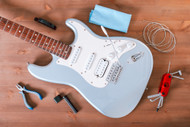How to string a guitar for each of the major guitar types
Jul 17th 2023
Whether you play an acoustic or electric guitar, high-quality guitar strings are crucial to getting the sweet sounds you want from your instrument. Strings are affordable too, so it's wise to spend as much as you can within your budget to get the best ones possible.
Even the highest-quality strings will wear out over time, however. You may notice your strings look or feel rough or rusty or just don't sound right. A string may break (hopefully while you are not in the middle of a performance). Just like practically everything else, guitar strings wear out over time. Acoustic guitar strings often need replacing after a couple of months. Because they are thinner, electric guitar strings may need replacement after only a couple of weeks.
Fortunately, replacing guitar strings is no big deal; as noted above, guitar strings are one of the more affordable replacement parts for guitars, and removing the old, worn strings and replacing them with brand-new ones is a relatively simple process.
The string replacement process for acoustic and electric guitars is similar. Strings and Beyond is happy to help you with this primer on how to string a guitar for each of the major guitar types.
What You'll Need
For both acoustic and electric guitars, you will need some supplies. Get them in advance and set them close at hand where you will be working. You will need a new set of quality strings, of course. You should also have a pair of clippers for cutting strings during removal and replacement. If you will be working with metal strings, wire clippers are a good idea. For some guitars, you may need an Allen wrench, a.k.a. a hex wrench. Finally, although it is not an absolute necessity, a string winder will make the job of removing and installing strings faster.

Some experts recommend removing and replacing only one or two strings at a time, saying this method makes it easier to tune your guitar and that removing all the strings at once could even damage your guitar through a change in neck tension. Others advise removing and replacing the entire set at the same time. After you have removed the set, you can clean the frets, fretboard and other components of the guitar more easily, they reason. You might try each way and decide which works best for you.
Acoustic Guitar Restringing
Before you restring an acoustic guitar, you will need to remove the old strings. Begin by releasing tension by turning the pegs at the headstock at the top of the neck. You can do this with a string winder or by hand. When the tension is relaxed, cut the string with clippers above the guitar's sound hole. Remove the cut top section of the string from the top of the guitar.
Now you will remove the remaining portion of the string attached to the bottom of the guitar. To do this, pull or pry up the post from the bridge. Some string winders come with a tool to help you do this. You can also use a pair of pliers if the post is stubborn. The end of the string will come out with the post. If the strings are tied to the bridge rather than kept in place with pegs, simply cut the loops.

Now you are ready to install a new string. Begin at the bottom by putting the string in the groove of the bridge pin. Then insert the string and the post into the bridge hole You should hear it click tight when you pull gently on the string. Some folks cover the post with a cloth and gently tap it with pliers to make sure it is securely in place. For looped strings, simply tie a new know for each string at the bridge.
Now run the string up to the headstock. From the middle of the headstock, run the string through the hole in the machine head. Starting at the top to provide the proper angle, wind the machine head with a string winder or by hand until you have the proper tension. Once you have finished, if there is excess string coming off the machine head, make sure to clip it off with your clippers. Now you are ready to repeat the process with the rest of the strings on your guitar.
Electric Guitar Restringing
The procedure for restringing an electric guitar is similar to that of restringing an acoustic guitar. Have all the necessary supplies and tools at the ready, including a package of new strings, a pair of clippers and an optional string winder.
You will start by removing the electric guitar strings. Loosen the tension of each string with the string winder or by hand. Then clip the string off near the middle of the guitar. Remove the top portion of the string from the peg and discard.
Next you will remove the bottom portion of the string from the bridge. On some electric guitars, you may have to flip the guitar over and remove the back plate to gain access to the string ends. Once you have loosened the bridge attachments, simply push the strings out to remove.

Install new strings by beginning at the bridge. In electric guitars with back plates, you will need to feed the new strings through the holes in the back plate. Then run them to the headstock, where you will thread each string through the hole in each tuning peg. Use a string winder or your hands to work the string around the machine head from top to bottom for proper alignment.
Once you are done, remember to clip off any excess string from the machine heads with your clippers. Tune your guitar and you are good to go!

